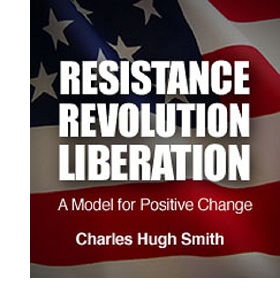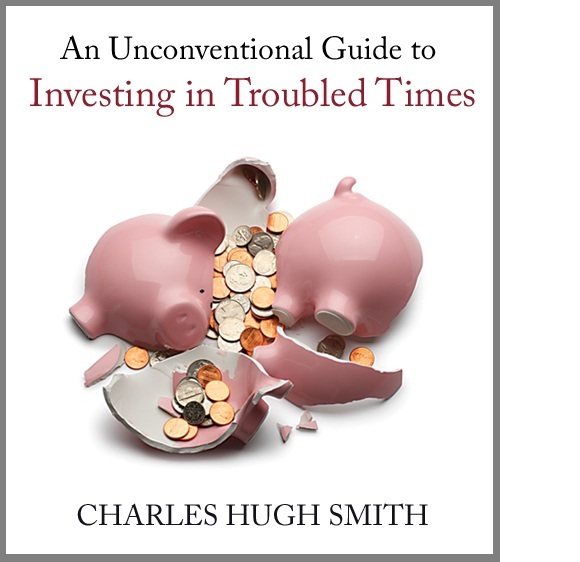

|

|
|||||||||||||
|
What Happens When All the Money Vanishes Into Thin Air? (April 24, 2012) Issuing debt and printing money do not create wealth. All they can create is a temporary illusion of wealth. I could have written "if all the money vanishes," but that would be misleading, for all unbacked money will most certainly vanish into thin air. The only question is when, not if. Frequent contributor Harun I. explains why:
Those who fail to understand that the Status Quo is impossible to maintain will be shocked when the disintegration is undeniable. But the whole thing was perverse to begin with. Words like capitalism and meritocracy are thrown around to make people feel good when, in reality, we have never owned anything, not even ourselves. Thank you, Harun. Many observers have addressed the key concept here, which boils down to this: paper money is an abstract representation of the real world. This can be explained by a simple example. If there is $100 in the money supply, and $100 of goods and services to trade, then $1 will be exchanged for $1 of goods and services. If the money supply suddenly increases by $100, then the value of the existing $100 declines by half, as the money supply is now $200 and the supply of goods and services remains unchanged. Thus it now takes $2 to buy what $1 once bought in goods and services. Holders of the currency have had half the value of their currency (what we call purchasing power) stolen by the central bank that issued the additional $100 in money supply. Here is the primary point: issuing debt and printing money do not create wealth. All they can create is a temporary illusion of wealth. (This is drawn from Chapter One of Resistance, Revolution, Liberation: A Model for Positive Change (Kindle); you can read Chapter One for free.) Here is another example. Let's say that a small group is stranded on a desert island that supports a handful of coconut palms. Each palm produces a limited number of coconuts each season. To facilitate trade, the group issues a currency that represents one coconut. (Lacking a printing press, they have to laboriously carve out a pattern on a rock to imprint a difficult-to-counterfeit stamp on the currency.) This system works well, as the currency issued matches the number of coconuts harvested annually (for simplicity's sake, let's say that's 100). 100 pieces of currency are issued to match the 100 coconuts that exist in the real world. The currency (let's call it the quatloo) is an abstract representation of the goods available, i.e. the coconuts. But then a wise-guy (i.e. the "central banker" on the island) realizes that if he prints another 100 quatloos, he and his buddies can buy up all the coconuts and fish without having created any real goods in the real world: the abstraction is used to con people out of their real coconuts. The residents quickly catch on, and the "price" of coconuts rises to 2 quatloos. The wise-guy is addicted to the scam, and so he prints 1,000 quatloos, and then issues quatloos in denominations of 1 million. Soon enough, each coconut costs 1 million quatloos. Creating debt and paper money does not create real goods and services or real wealth. As Harun observed, we have been promised trillions of dollars that can supposedly be traded for trillions of dollars in real goods and services, and buyers of bonds have been promised trillions of dollars of the same artificial exchange of paper for real goods. Just as on the desert island, the growth of actual goods in the real world lags the growth of money, i.e. abstract representations of real goods. The U.S. Central State (Federal government) has borrowed and squandered $6 trillion over the past four years, and the actual production of goods and services has not risen at all when adjusted for inflation. The central bank (the Federal Reserve) has expanded its balance sheet by $2 trillion, and yet all the assets it have tried to force higher are actually lower when measured in real goods such as gold, oil, wheat, etc. It's easy to expand the money supply and difficult to expand the actual production of real goods in the real world. Expanding the money supply and issuing debt that lacks collateral is just like printing quatloos on the desert island: you can print a million quatloos but that doesn't create a single additional coconut. If you print enough quatloos, then people will no longer accept them in exchange for coconuts. You will actually need a real coconut to exchange for fish. This is why Greek towns are reportedly reverting to barter, the exchange of real goods for other real goods. We can anticipate that silver and gold will soon enter the barter as means of exchange that can't be counterfeited or printed by wise-guys (central bankers). We can also anticipate the issuance of letters of credit, a practice that stretches back to the trading fairs of Medieval Europe, as described by Fernand Braudel in his three-volume history of early capitalism, The Structures of Everyday Life (Volume 1), The Wheels of Commerce (Volume 2) and The Perspective of the World (Volume 3). Since gold was in insufficient supply, letters of credit were issued and accepted on a basis of trust. At the end of the great fairs, the letters were exchanged and payment of balances due made in gold or silver. Thus 99 coconuts could be traded for 100 dried fish via letters of credit and the balance due in gold or silver was the value of 1 dried fish--a mere 1% of the total value of goods exchanged. This is what happens when abstract representations, i.e. "money," vanish into thin air. Alternative systems of exchanging goods and services arise: actual goods are exchanged via barter, tangible concentrations of value that cannot be counterfeited such as gold and silver are used as a means of exchange, letters of credit or equivalent are traded and settled with tangible goods or gold/silver, and eventually, a means of exchange ("money") that is backed by tangible goods in the real world that can be trusted to actually represent the value being traded might enter the market. That which is phantom will vanish into thin air, while the real goods and services remain to be traded in the real world.  Resistance, Revolution, Liberation: A Model for Positive Change
(print $25)
Resistance, Revolution, Liberation: A Model for Positive Change
(print $25)
(Kindle eBook $9.95) Read the Introduction (2,600 words) and Chapter One (7,600 words) for free.
We are like passengers on the Titanic ten minutes after its fatal encounter with the iceberg: though our financial system seems unsinkable, its reliance on debt and financialization has already doomed it.

If this recession strikes you as different from previous downturns, you might
be interested in my book
An Unconventional Guide to Investing in Troubled Times (print edition)
or
Kindle ebook format. You can read the ebook on any
computer, smart phone, iPad, etc. Click here for links to Kindle apps and Chapter One.
The solution in one word: Localism.
Of Two Minds Kindle edition: Of Two Minds blog-Kindle

"This guy is THE leading visionary on reality.
He routinely discusses things which no one else has talked about, yet,
turn out to be quite relevant months later."
NOTE: gifts/contributions are acknowledged in the order received. Your name and email remain confidential and will not be given to any other individual, company or agency.
Or send him coins, stamps or quatloos via mail--please request P.O. Box address. Subscribers ($5/mo) and contributors of $50 or more this year will receive a weekly email of exclusive (though not necessarily coherent) musings and amusings. At readers' request, there is also a $10/month option. The "unsubscribe" link is for when you find the usual drivel here insufferable.
All content, HTML coding, format design, design elements and images copyright © 2012 Charles Hugh Smith, All rights reserved in all media, unless otherwise credited or noted. I would be honored if you linked this essay to your site, or printed a copy for your own use.
Terms of Service:
|
Add oftwominds.com to your reader:
My Big Island Girl
Instrumentals by my friend
|
| Survival+ | blog fiction/novels articles my hidden history books/films what's for dinner | home email me | ||